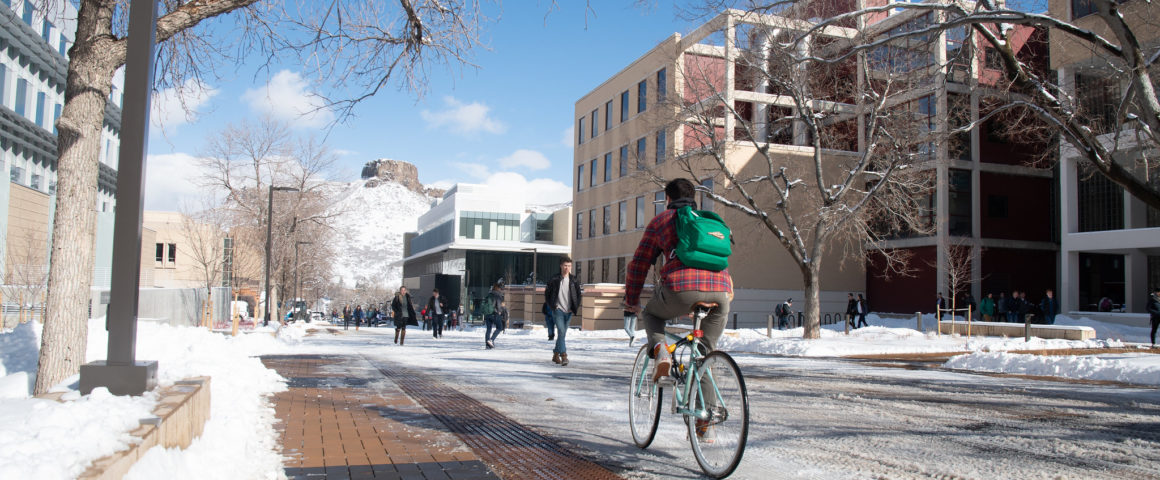It’s between classes and the middle of the day. To get between Alderson and CoorsTek you have to weave your way through the crowd, it’s a busy thoroughfare. A car is stuck in the middle of the road, trying to inch its way forward through the uncaring swarm of students. They’re likely to be stuck there for the next few minutes until the crowd thins. While most people wouldn’t give the street they’re walking on a second thought, it might be subtly conveying a message without anyone realizing it.
Traditionally roads made of small elements packed together, like the bricks on 16th street, were made of cobblestones, however, these days cobblestone roads are uncommon. But that section of road isn’t even made from cobblestone-it’s a material known as “concrete pavers”. Cobblestone is made from small, round smooth river stones. They were used as road material in the past because they were cheap and plentiful. But then concrete and eventually asphalt became cheaper to use. As a result, 96% of all paved roads/streets in the US are currently paved with asphalt. However, some cobblestone-type streets remain in older or historic areas around the world (especially in Europe). But on our chunk of 16th street, the concrete pavers are designed to mimic the look of laid brick. They have a historic style and are useful for creating an authentic and established look. Many buildings on campus also go for this scholarly bricked look. This chunk of road is the divide between the concrete, brick-laden traditional school building of Alderson and the multi-textured metal and soaring windows of Coorstek. The street flows seamlessly into Alderson and some of the other building’s designs, giving them an established presence on campus.
There are a few other possible reasons why pavers would be used in an area. One advantage pavers have over concrete or asphalt is that they can flex with the temperatures. Water can freeze in the cracks and the earth can shift a bit underneath without much damage. When we get snow, it can melt through the road without puddling up and, if damage does occur, replacing a few bricks can be easier than fixing a whole chunk of road. But if this was the only reason, then why are only a few blocks paved this way while other roads through campus stick to standard asphalt? There must be other reasons. Could it be that the school wanted to make it an entirely pedestrian street, like the other bricked paths, but wasn’t able to?
As many have likely noticed, during high-traffic times (between class in the middle of the day), most street intersections have too many people for cars to cross. There’s always a few sitting at the intersection, waiting for the pedestrians to thin. Some drivers are impatient, inching forward – while others wait, bored. You can tell they’ve been stuck there for a few minutes already or will be. A lot of students only have 10 minutes to get where they’re going, and the cars will have to wait. Could this have influenced the road design, the presence of pedestrians? In other areas of campus, the same brick pattern is used, but the only vehicles that drive on it are Mines work vehicles. These areas are designed for pedestrians. In this section of the road between Alderson and CoorsTek, non-Mines vehicles drive on the bricks too.
These pavers have the advantage of signifying to cars that the area is more than just an average street. Imagine you’re driving on an asphalt road, but then turn onto one with bricks or cobblestones. Something has changed, there’s something special about this road, and it makes you more aware of your surroundings. You might wonder, can I turn here? Is this a space where cars are allowed?
If you look at the little sign at the end of the street, it says “shared street”. This is a concept that is on the rise in urban planning, also sometimes called a “living street”. The idea of this is that by removing barriers and sections of the road, people are forced to pay more attention to their surroundings, and ultimately, become cooperative. To most of us, seeing bricks, pavers, or cobblestones means “people!” Cars realized that they need to be careful, cautious, they might not be allowed here. Somewhere in translation, we inherit the understanding that this different road type means a place for people. So just seeing it as a street surface, pedestrians feel free to walk wherever they would like, be freed from the sidewalks, and cars realize that there are likely people in this area as well. Next time you walk around campus, you might look out for other pieces of unnoticed design that shape our world.



'Design of Mines: bricks beneath our feet' has no comments
Be the first to comment this post!